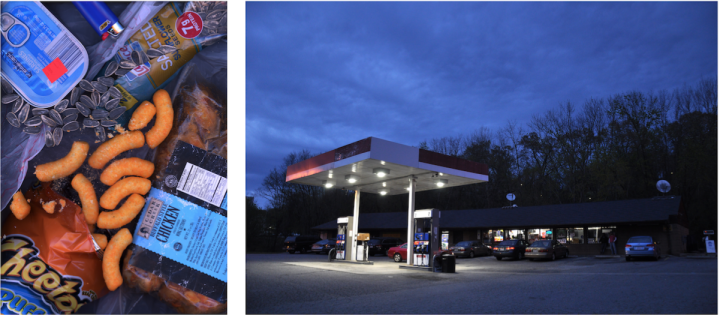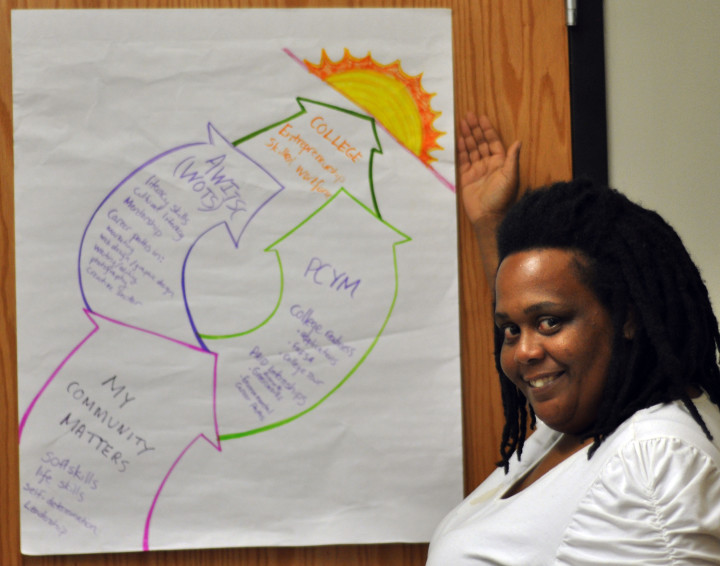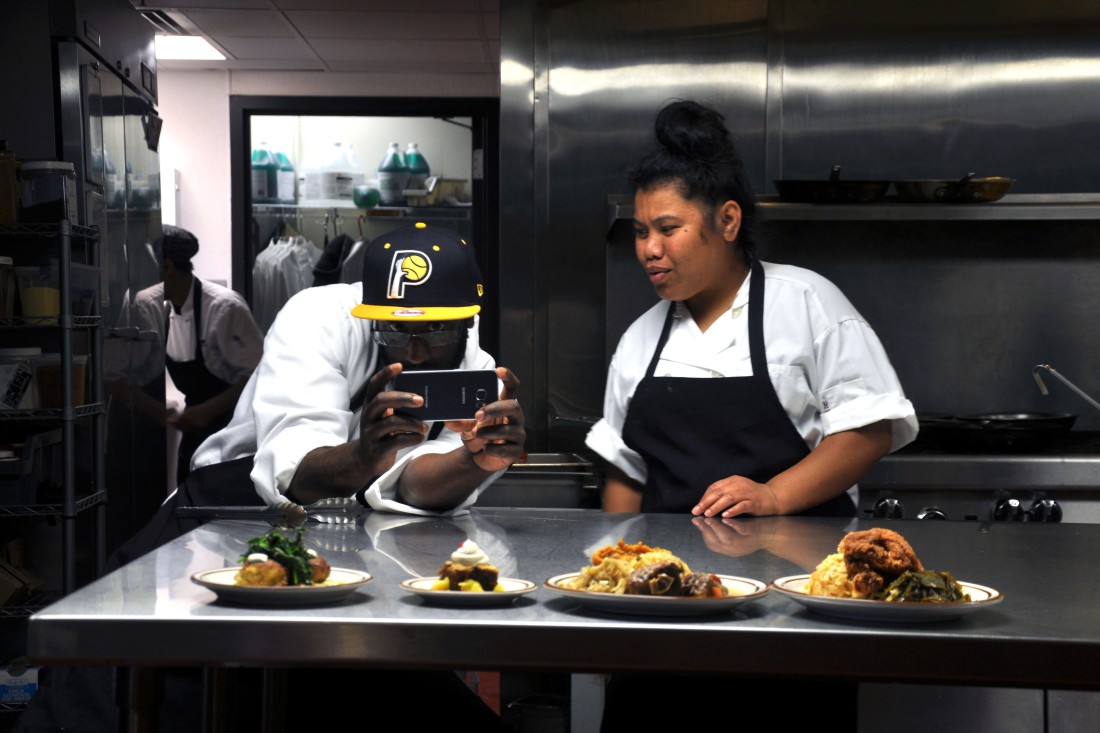Since May 2015, UNC Asheville graduate Erin Daniell has conducted an ongoing research project focusing on the roots and modern realities of food insecurity in Asheville’s historically black Southside community. Daniell lived in Southside until she moved overseas in late July to work as a Peace Corps volunteer. This is the second of two stories she wrote for Xpress presenting her findings from the study. The first, “Legacy of Loss,” appeared in the July 19 issue.
Nearly 100 years ago, there were 22 grocery stores in Asheville’s historically black Southside neighborhood. Today there are none. This shift in the community’s food access came from the outside in the early 1970s in the form of urban renewal, a series of redevelopment programs that dramatically altered Southside’s streets, transferred property ownership and displaced hundreds of its residents into public housing. By 1975, Southside’s grocery stores had disappeared.
Today, residents who want to buy food in Southside go to Green’s, a gas station on Depot Street with a small convenience mart that sells processed foods like chips and sodas. Nestled between the rapidly growing areas of South Slope and the River Arts District, Southside is gentrifying quickly in the competitive housing market. This means an increasing number of middle-class, primarily white people are moving into the neighborhood, sometimes displacing longtime, primarily black, Southside residents. Hipsters, artists and students are moving in, while residents watch their home community morph before their eyes.
The U.S. Department of Agriculture identifies Southside as one of Asheville’s six food deserts (defined as areas where residents lack access to nutritious, affordable food). The neighborhood is also home to five of the city’s nine public housing complexes. In the 2010 U.S. census, 55 percent of Southside’s population was black.
Traveling for food
All Southside residents face the problem of being a long way from the nearest grocery store. But while a lack of food access is related to physical distance, the dilemma is often complicated by issues of class and race. According to the 2010 American Community Survey done by the U.S. Census Bureau, 9 percent of white Ashevilleans have no access to a vehicle compared with 27 percent of black Ashevilleans. With a statistically greater likelihood of having no car — and thus being more dependent on public transportation — the black residents of Southside experience food insecurity to a significantly higher degree than their newer white neighbors.

Shuvonda Harper, a lifelong black Southside resident and fourth-generation Ashevillean, is a mother of two and a public housing resident. In Harper’s experience, Southside has always been a food desert, meaning the closest grocery store for her has always been more than a mile away. Plus, growing up, her family didn’t own a vehicle, making the distance to groceries a logistical orchestration of carpools or multiple bus transfers. As a kid, Harper remembers, “There was this one gentleman that transported people [including my mother] to the store a lot … [for] a couple bucks of gas money.” As an adult, Harper coordinated rides from friends and family members in order to take care of her family’s basic nutritional needs until she recently was able to buy her own car.
Roy Harris, a 30-year black resident of Southside and recent retiree, routinely catches four buses round trip to do his grocery shopping at a Walmart about 5 miles from Southside. One June morning, Xpress rode along with Harris as he boarded the S4, then later caught the E1 for his regular shopping trip, which took one hour and 10 minutes one way. That journey then had to be repeated to get back to his neighborhood.
Harris offers some helpful recommendations for the grocery-busing strategy. “Get the minimum of what you need,” he says, especially if you are trying to make the next bus, and purchase “nothing real heavy because then that makes it real tough for you to get it back to your house.” Harris says that shopping using the ART system encourages the purchase of processed food items that have a longer shelf life. He is less likely to buy fresh fruits and vegetables for practical reasons, he says. Harper agrees this was also a part of her strategy when she was dependent on asking for rides to the grocery store.
Healthy access points
Longtime residents say that before the East Riverside urban renewal project was carried out in Southside in the 1970s, the neighborhood boasted fruit trees, vegetable gardens and corner stores carrying fresh produce (see “Legacy of Loss” in the July 19 issue of Xpress). But during the urban renewal period, the local government used eminent domain to buy houses from primarily black homeowners, moving residents from homes with gardens and fruit trees to public housing. Simultaneously, drastic changes to the neighborhood’s roadways caused the corner stores to disappear. The resulting limited access to wholesome foods has caused a change in many residents’ diets to predominantly processed foods.
But lately, some healthy access points have developed in the neighborhood. Green Opportunities’ Kitchen Ready culinary training program has a pop-up kitchen at the Arthur R. Edington Education & Career Center, which serves the public lunch and occasional dinners on a donation basis. Much of the food served there comes from a garden that’s cultivated behind the center, which also gives away produce to Southside residents.
Patchwork Urban Farms, a local multiplot urban agricultural network, also operates a pop-up produce stand on Choctaw Street. But while these options are present in the neighborhood, they are not capable of replacing the stability and convenience of a supermarket with full-time hours of operation and offering a wide variety of food items.
Changing demographics
Harris says that when he first moved to Bartlett Street in 1986, all 14 of the street’s homes were occupied by black folks, mostly headed by matriarchs of the family. Today, only five of those original 14 houses are occupied by black Southsiders. Although he remembers that when he moved to Bartlett, “you could hear kids’ voices up and down the street,” the street’s newcomers, he says, are predominantly single and white with no children.

“I can’t figure out if my house is moving toward the River Arts District or toward South Slope. … Whether it’s one way or the other, it’s moving toward one of them,” he muses. “Are my new neighbors interested in my community? And how much are they interested in this community down to the gritty nuances?”
Collin Demos, a barista at West Asheville’s Odd’s Café and white resident of Southside for the past two years, admits, “I definitely knew absolutely nothing about the neighborhood [when we moved in].” His main reason for renting his apartment was that “it was the cheapest and the nicest for the price.” Demos says he observes rather than participates in the Southside community as he has not connected with any of his neighbors, many of whom have lived in the area for years and even decades.
“My community is a lot in West Asheville — like at Odd’s. I know a lot of the people that hang out there, and I hang out with all my work buddies,” he says. “Where I met most of my friends is up there, and I don’t really know anyone that lives down here [Southside].” Demos wonders if his sense of community might be different if he were able to shop at a grocery in Southside where he could see his neighbors and chat with them. Instead, he drives to Earth Fare, a high-end grocery store, two to three times a week, he says, “because they offer consistently good-quality, decently priced produce and have a large bulk section.”
Sam Singer, who is white and a recent graduate of UNC Asheville, has called Southside home for a few years. For her grocery needs, Singer prefers to walk to Hopey & Co. on the northern edge of the neighborhood, where she buys mainly fresh produce. “The produce box I split between my roommate and I has a lot of good, delicious food,” she says. “I try to eat that as soon as possible. I buy a few processed items when I don’t have a ton of time to make something.”
Hopey & Co. is the closest grocery store to Southside and is even within a mile of some parts of the neighborhood. However, as a discount grocery that caters to a predominantly white clientele, Hopey & Co. is an unappealing option to many black Southsiders who are likely to bus across town to Walmart or Ingles rather than spend their money on almost expired goods.
Invisible line
Although the restaurants and other businesses of the gentrified River Arts District, which was once a part of Southside, are just a quick walk away, black residents may not always feel welcome in those establishments. “It’s very clearly not a space for the people who live in and built the Southside community,” says Singer. “I’m not talking about myself or other gentrifiers. I’m talking about people of color who have been living in Southside, some for generations, [who] are systematically kept out of the River Arts District. The restaurants, shops and people who frequent the area aren’t noticing that the closest grocery store to Southside is Hopey, which doesn’t have everything someone may need. They aren’t noticing the invisible line that is drawn that says, ‘You don’t belong here if you can’t afford it.’”
Harris agrees. “You can see it’s almost like a dividing line — a railroad track, as they used to say in our culture,” he says, alluding to the idea that during the era of segregation, communities were often divided by the railroad tracks, with blacks living on one side and whites on the other. Harris’ observation is based not only in the physical dissonance between Southside and the RAD but also in the cultural incongruity. While there are now more restaurants near Southside than in the previous three decades, they are not economically accessible or culturally appealing to all the residents living closest to them.
Harper also notes the sharp divide between her economically challenged community and the bustling RAD. “The pretty flowers don’t start till you turn that corner,” she says. “Crazy kudzu all on the hill [by the Livingston Apartments] and everything, but pretty flowers right there around that corner.”
She adds, “I’m not knocking [the RAD]. I just really wish there were more of us in the space.” Harper says one thing she’d love to see is artwork by a Southside resident featured on the shipping container mural across from the Pink Dog Creative building. “True enough, there’s been some unique stuff up there,” she says. “Well, give us a shot, because we’ve got some crazy, mad artists in our community that would love to have the opportunity to put up a mural on that thing.”
A mural recently featured across from the Pink Dog was a piece that said “CHANGE” in black and white paint. When it was up there, Harper says, it had her community wondering, “Change for whom?”






neighborhoods vary in cities everywhere…this is nothing but sour grapes…why did all the Southside grocery stores close ? the people did not leave…
In the 70’s Asheville broke up the main street that was full of bustling black owned businesses and had people move from their houses and live in public housing, recently created neighborhoods, which broke up the community and made thriving businesses fail, closing the groceries. Most grocery stores are over 2 miles away.
oh yeah, you mean when the democrackkks SEGREGATED all the poor people into public housing, right ? tore down their homes, democrackkks always knows what’s best for everbody…
The disappearance of the community/corner grocery store is not just a Southside or Asheville phenomenon. A number of factors contributed to it. Wal-Mart and large supermarkets for one. The majority of shoppers at the old mom and pop stores tended to be regulars and older people. Many folks ran a store on the side – with a spouse, child or hired employee running the store while they worked a regular job – when these folks died or retired, nobody wanted to try to keep it running as by that time, competition from big stores further out was too much.
Also, changing regulations on fuel tanks, pumps, etc., caused a lot of the old stores quit carrying petroleum products – was too expensive to comply, so they just got rid of their tanks and stopped selling gas, oil and kerosene. When I was in high school, there were at least 10 small gas/grocery stores within an easy drive from our house. Now there are only 3 of the original ones being used as stores – and all of them were bought by one company.